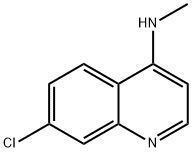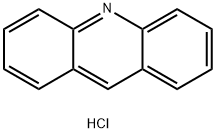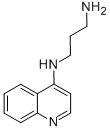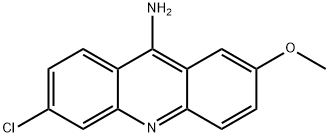6-CHLORO-9-[3-(2-CHLOROETHYLAMINO)PROPYLAMINO]-2-METHOXYACRIDINE DIHYDROCHLORIDE
Synonym(s):6-Chloro-9-[3-(2-chloroethylamino)propylamino]-2-methoxyacridine dihydrochloride
- CAS NO.:17070-45-0
- Empirical Formula: C19H22Cl3N3O
- Molecular Weight: 414.76
- MDL number: MFCD00013320
- EINECS: 241-129-4
- SAFETY DATA SHEET (SDS)
- Update Date: 2024-12-18 14:15:30
![6-CHLORO-9-[3-(2-CHLOROETHYLAMINO)PROPYLAMINO]-2-METHOXYACRIDINE DIHYDROCHLORIDE Structural](https://img.chemicalbook.in/CAS/GIF/17070-45-0.gif)
What is 6-CHLORO-9-[3-(2-CHLOROETHYLAMINO)PROPYLAMINO]-2-METHOXYACRIDINE DIHYDROCHLORIDE?
Chemical properties
yellow crystals or powder
The Uses of 6-CHLORO-9-[3-(2-CHLOROETHYLAMINO)PROPYLAMINO]-2-METHOXYACRIDINE DIHYDROCHLORIDE
Acridine Mutagen ICR 191 is a probe used in the Ames test using??Salmonella and E. coli.
What are the applications of Application
Acridine Mutagen ICR 191 is a probe used in the Ames test using Salmonella and E. coli
Definition
ChEBI: A hydrochloride salt resulting from the reaction of acridine half-mustard with 2 mol eq. of hydrogen chloride.
General Description
Yellow crystalline or chunky solid.
Air & Water Reactions
May be sensitive to air. .
Reactivity Profile
6-CHLORO-9-[3-(2-CHLOROETHYLAMINO)PROPYLAMINO]-2-METHOXYACRIDINE DIHYDROCHLORIDE reacts as a weak acid.
Fire Hazard
Flash point data for 6-CHLORO-9-[3-(2-CHLOROETHYLAMINO)PROPYLAMINO]-2-METHOXYACRIDINE DIHYDROCHLORIDE are not available. 6-CHLORO-9-[3-(2-CHLOROETHYLAMINO)PROPYLAMINO]-2-METHOXYACRIDINE DIHYDROCHLORIDE is probably combustible.
Properties of 6-CHLORO-9-[3-(2-CHLOROETHYLAMINO)PROPYLAMINO]-2-METHOXYACRIDINE DIHYDROCHLORIDE
| Melting point: | 261-262 °C |
| storage temp. | 2-8°C |
| solubility | DMSO: soluble |
| form | Solid |
| color | Light Yellow to Yellow |
| BRN | 8176205 |
| EPA Substance Registry System | 2-Methoxy-6-chloro-9-(2-chloroethylaminopropylamino)acridine dihydrochloride (17070-45-0) |
Safety information for 6-CHLORO-9-[3-(2-CHLOROETHYLAMINO)PROPYLAMINO]-2-METHOXYACRIDINE DIHYDROCHLORIDE
| Signal word | Danger |
| Pictogram(s) |
 Skull and Crossbones Acute Toxicity GHS06  Health Hazard GHS08 |
| GHS Hazard Statements |
H350:Carcinogenicity |
| Precautionary Statement Codes |
P202:Do not handle until all safety precautions have been read and understood. P260:Do not breathe dust/fume/gas/mist/vapours/spray. P264:Wash hands thoroughly after handling. P264:Wash skin thouroughly after handling. P280:Wear protective gloves/protective clothing/eye protection/face protection. |
Computed Descriptors for 6-CHLORO-9-[3-(2-CHLOROETHYLAMINO)PROPYLAMINO]-2-METHOXYACRIDINE DIHYDROCHLORIDE
New Products
(S)-3-Aminobutanenitrile hydrochloride 4-Methylphenylacetic acid N-Boc-D-alaninol N-BOC-D/L-ALANINOL Tert-butyl bis(2-chloroethyl)carbamate 3-Morpholino-1-(4-nitrophenyl)-5,6-dihydropyridin- 2(1H)-one Furan-2,5-Dicarboxylic Acid Tropic acid 1-Bromo-3,5-Di-Tert-Butylbenzene S-2-CHLORO PROPIONIC ACID ETHYL ISOCYANOACETATE 2-Bromo-1,3-Bis(Dimethylamino)Trimethinium Hexafluorophosphate 4-IODO BENZOIC ACID 3-NITRO-2-METHYL ANILINE 1-(2,4-DICHLOROPHENYL) ETHANAMINE (2-Hydroxyphenyl)acetonitrile 4-Bromopyrazole 2-(Cyanocyclohexyl)acetic acid 4-methoxy-3,5-dinitropyridine 1-(4-(aminomethyl)benzyl)urea hydrochloride 2-aminopropyl benzoate hydrochloride diethyl 2-(2-((tertbutoxycarbonyl)amino) ethyl)malonate tert-butyl 4- (ureidomethyl)benzylcarbamate Ethyl-2-chloro((4-methoxyphenyl)hydrazono)acetateRelated products of tetrahydrofuran





![6-CHLORO-9-[3-N-(2-CHLOROETHYL)ETHYLAMINO]PROPYLAMINO-2-METHOXYACRIDINE DIHYDROCHLORIDE](https://img.chemicalbook.in/CAS/GIF/146-59-8.gif)


You may like
-
 Acridine Mutagen ICR 191 CAS 17070-45-0View Details
Acridine Mutagen ICR 191 CAS 17070-45-0View Details
17070-45-0 -
 2033-24-1 98%View Details
2033-24-1 98%View Details
2033-24-1 -
 1975-50-4 98%View Details
1975-50-4 98%View Details
1975-50-4 -
 2-HYDROXY BENZYL ALCOHOL 98%View Details
2-HYDROXY BENZYL ALCOHOL 98%View Details
90-01-7 -
 2-Chloro-1,3-Bis(Dimethylamino)Trimethinium Hexafluorophosphate 221615-75-4 98%View Details
2-Chloro-1,3-Bis(Dimethylamino)Trimethinium Hexafluorophosphate 221615-75-4 98%View Details
221615-75-4 -
 61397-56-6 CIS BROMO BENZOATE 98%View Details
61397-56-6 CIS BROMO BENZOATE 98%View Details
61397-56-6 -
 14714-50-2 (2-Hydroxyphenyl)acetonitrile 98+View Details
14714-50-2 (2-Hydroxyphenyl)acetonitrile 98+View Details
14714-50-2 -
 118753-70-1 98+View Details
118753-70-1 98+View Details
118753-70-1
Statement: All products displayed on this website are only used for non medical purposes such as industrial applications or scientific research, and cannot be used for clinical diagnosis or treatment of humans or animals. They are not medicinal or edible.